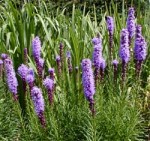
Also called blazing star, this clump-forming herbaceous perennial is native to eastern US and is a member of the aster family, Asteraceae, that also includes daisy, yarrow, and lettuce. Corms give rise to a tuft of medium green grass-like leaves up to 12″ long. In summer a leafy terminal spike 6-12″ tall appears bearing sessile buds of flowerheads that open from the top first. Each flowerhead is up to 3/4″ across and consists only of fluffy purple disc flowers with no ray flowers. Plants provide a strong vertical accent in the garden (or in a vase arrangement), and look especially attractive in drifts or small groups. Cultivars are available with white, pink, and various shades of purple. Gay feather tolerates heat, cold, drought, and poor soil, and is especially attractive in a meadow garden. The genus name, Liatris, is of unknown origin. The specific epithet, spicata, is the Latin word meaning bearing spikes and refers to the flowering habit.
Type: Herbaceous perennial.
Bloom: Lavender purple flowers are borne on tall spikes in mid summer. The buds open at the top of the spike first and continue opening downward.
Size: 18-30� H x 24�W.
Light: Full sun.
Soil: Prefers moist, well-drained, average soil but tolerates much less.
Hardiness: Zones 3-9.
Care: Cut flowering spikes to the basal tuft of leaves when blooming has finished in order to freshen up the garden.
Pests and Diseases: Generally pest free but can be attacked by powdery mildew in late season when humidity and heat are high especially if stressed by drought.
Propagation: Dig up corms in the fall and divide with a sharp knife to increase the number of plants, but division not necessary. Can be grown from seed but may not come true.
Companion plants: Goldenrod (Solidago spp.), Black eyed Susan (Rudbeckia fulgida �Goldsturm), coneflower (Echinacea purpurea), Boltonia asteroids, daylilies (Hemerocallis hybrids) and various grasses such as feather reed grass (Calamagostis x acutiflora �Karl Foerster�) or fountain grass (Pennisetum sp.).
Comments: Attracts bees, butterflies and birds. Great cut flower.
